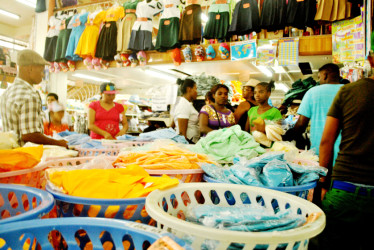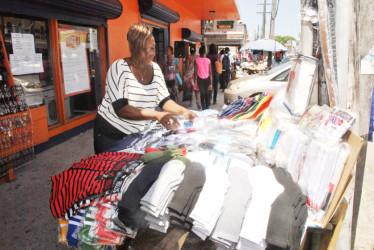From as early as last Monday there had been clear indications that the week that has come and almost gone with lightning speed would witness a frantic last-minute rush by parents to kit out their children for the new academic year. We can say what we like about the downside of the ninth-hour rush but in numerous cases economic realities require that we understand the economic challenges that the start of a new school year brings for parents.
Liquidity limitations dictate purchasing patterns and what Stabroek Business found out based on our conversations with several parents earlier this week is that purchases for the new school year are made ‘as the money comes in,’ that could mean in dribs and drabs, beginning sometime with the more expensive items – .text books. Sometimes – and again this is a function of liquidity – the purchases begin at the cheaper end.
Whichever way it goes the parents explain the purchases for the new school year are staggered over several pay periods….as many as a dozen for those fortnightly paid workers and three (June, July and August month ends) for monthly paid workers. The week that is almost at an end provides the last opportunity to ensure that the children begin the new school year fully kitted out.

These days there is sometimes the ‘saving grace’ of a subsidy, provided by contributions in cash or kind from relatives abroad; there are box hands too and loans from Credit Unions and sometimes salary advances. What manifests itself in the seeming chaos of the last-minute back-to-school rush by parents is quite often a delicate financial balancing act.
The stationery store Payless is just a stone’s throw from the office of the Stabroek News. As early as Monday it was packed to near capacity with agitated parents and their animated children. Acquisitions of stationery were being preceded by negotiations between the two sides mostly on issues of price, style and durability. These days, it seems that arguments about affordability that used to be trotted out by parents not too many years ago have ‘lost out’ to contemporary counter-arguments about brand name preferences. The children, it seems, holds sway.
At Payless, a store on Wellington street close to Robb street that has grown in popularity for its stationery offerings there was a condition close to commotion for much of the week. Hard-covered notebooks – which now appear to have virtually taken the place of soft-covered exercise books, even at the primary school level – were going fast. Some mothers in the store were agreeing that the prices of the notebooks at this particular store were as good the pavement…if not better.
We sought to get a verdict as to where prices had gone since the end of the last school year. No one seemed particularly sure though a great many mothers were inclined to the view that there may be some measure of substance to public gossip about a decline in money circulation since the general elections earlier this year. We found that some of the established high street stores – like Kirpalani’s – were offering regular exercise books at $540 per dozen whilst the pavement vendors had priced theirs at $600. In stores, the hard-covered books were being sold at $1,800 a dozen. Pavement vendors were asking an additional $200 per dozen.


For as long as the cost of living remains where it is no amount of moral appeals are likely to sate what has become the enormous appetite for copied text books. The stores that offer those texts still keep their prices probably a third below those of the published texts. Those were the stores – towards the end of the week – that attracted parents hoping that their last minute efforts did not mean that the key texts had long been sold out.
One has to give credit to the mothers who braved the crush at Guyana Stores to purchase school uniforms in the course of the week and some of whom were thumbing their noses at the government’s $2,000 school uniform voucher. In some instances a single complete girls’ school uniform can cost as much as $5,000.
The uniform vouchers are intended to be a subsidy. They can be particularly handy for small purchases like stationery and low-priced school accessories. Accordingly, it would make sense to allow small vendors offering those items to accept the vouchers. Last week, only a handful of vendors in the downtown arcade was accepting the vouchers and a few parents were wondering aloud as to just how they were expected to utilise them.
By midday the store assistants at Guyana Stores had become exhausted from folding and re-packing the garments multiple times; the various uniforms lie in unkempt piles and locating sizes is an exercise in futility. Whilst Stabroek Business was there a few parents who had reached the end of their tether were fitting their children with irregular sizes and insisting that those ‘would do fine.’ There can be no question that buying school uniforms during the final week before the new school year starts amounts to an unpardonable lack of sound judgment.

Like shoes, haversacks, these days, are as much fashion statements as they are utility items. By and large the low-end ones are left hanging on display in stores as well as on pavement shop fronts. These days, parents are placed under pressure to hunt down haversacks that can cost as much as $15,000.00 each -.either that or the top brands must be ordered on the internet.
This year shoe acquisitions were a point of interest. This week, Guyana Stores was offering boys’ school shoes at prices ranging from $3,500 to $5,500. These, however, were attracting only minimal attention. Within that price range the quality of the shoes is sometimes considered to be suspect. Those shoes that were more in demand, brand names like Nike, Piccadilly, Highland, Pierre Dumas were being offered in the downtown Shopping Arcade and some downtown stores at starting prices which, in some instances, doubled the maximum prices on offer at Guyana Stores.
The start of the new school year rivals the pre-Christmas period as a season of windfall for the pavement vendors as well as a period of unimaginable congestion on the streets and pavements. Throughout the week that sense of frantic trading, that condition of complete disorder, prevailed. Every year it seems as though more and more vendors take to the pavement around this time, the deduction being that the ‘regulars’ are joined by others who use the period to ‘catch their hands.’
Some of the vendors told Stabroek Business that the ‘last minute rush’ this year has come later than in previous years. They wonder aloud as to whether this year’s late distribution of school uniform vouchers (distribution only began last Monday) might have delayed the surge. That, however, is doubtful. Compared to the high cost of school supplies these days the voucher is no more than a proverbial drop in the ocean.
Not everyone fancies the congestion and confinement of the crowded stores. On the pavement the ‘crush’ is somewhat reduced and it is easier to strike bargains. This year, it seemed that apart from the regular fare of clothing accessories, shoe laces, lunch kits and less expensive haversacks larger volumes of school stationery were on sale on the pavement. Exercise books and multi-subject notebooks were piled high alongside pens, pencils, geometry sets et al, the prices may not have been that different from those in the stores but there is something to be said for the time saved by not having to joust with other shoppers inside the confined spaces of the stores and wait your turn to ‘cash’ and uplift your purchases. The downside of the pavement trading, of course, is that the activity removes any sense of public order from the downtown trading areas and leaves in its wake huge and unsightly piles of garbage which, happily these days, some vendors were seen putting into some semblance of order at the end of the trading day for the arrival of the garbage disposal truck.








